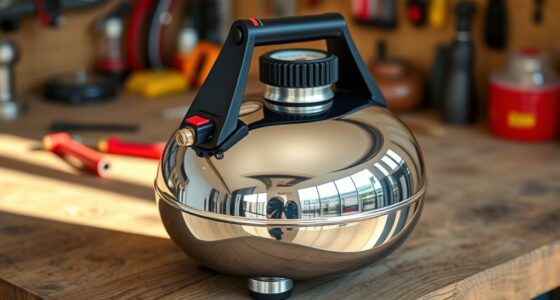Glass food storage containers are a healthier choice because they’re non-porous, free from harmful chemicals, and can handle extreme temperatures. However, they are fragile and can break easily if mishandled or dropped, especially during outdoor use. To avoid accidents, you need to take care when handling and storing them. Want to discover practical tips to maximize their benefits while minimizing risks? Keep exploring for valuable insights.
Key Takeaways
- Glass is a non-porous, chemical-free material that prevents food contamination and odor absorption, making it a healthier storage option.
- It offers high temperature tolerance, suitable for oven, microwave, and freezer use, but is prone to breakage if mishandled.
- Proper handling, such as gentle lifting and secure storage, reduces the risk of glass breakage and safety hazards.
- While durable due to modern manufacturing, glass remains fragile compared to impact-resistant plastics, especially during transport.
- Plastic may be preferable for impact-prone situations, but glass provides safer, eco-friendly, and non-toxic benefits for everyday use.
Why Choose Glass for Food Storage?
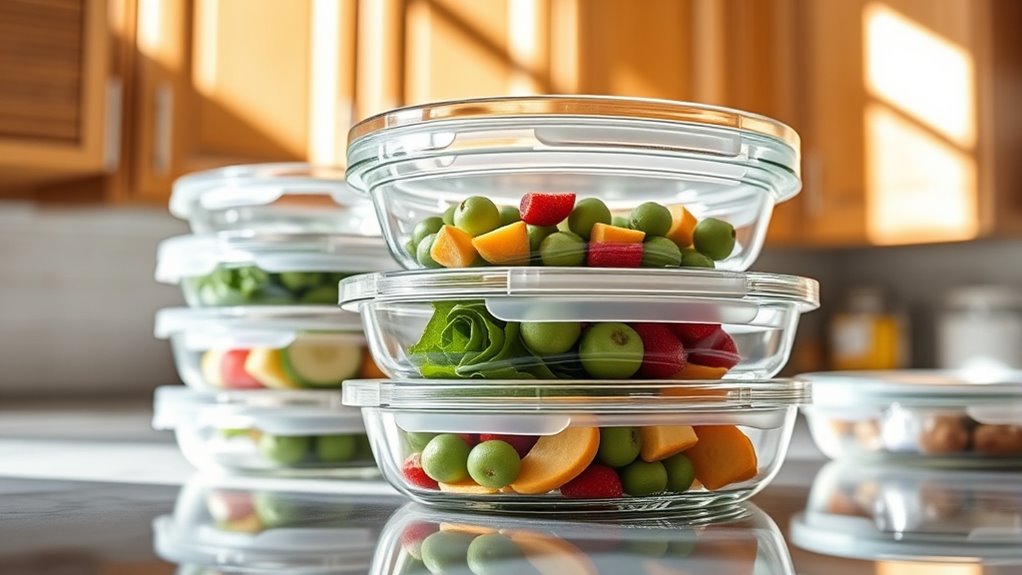
Choosing glass for food storage is a smart decision because it keeps your food pure and safe. Glass is a non-porous material that doesn’t absorb odors, flavors, or stains, ensuring your food stays fresh and uncontaminated. It’s also chemical-free, free from harmful substances like BPA and phthalates, making it a safer option for storing both food and beverages. Additionally, modern manufacturing techniques have improved the strength and durability of glass containers, reducing the risk of breakage during use. These advancements include the development of tempered and borosilicate glass, which are more resistant to thermal stress and impact. Plus, glass containers are versatile—they can withstand extreme temperatures, so you can use them in the oven, microwave, or freezer without worry. The use of automated production processes has also enhanced the consistency and quality of glass products, making them more reliable for everyday use. Innovations in manufacturing have contributed to creating more resilient glass options that are less prone to breaking. Being 100% recyclable and reusable indefinitely, glass supports environmental sustainability by reducing waste. While glass is durable when made from borosilicate or tempered materials, it’s important to handle it carefully to avoid breakage. Additionally, advancements in automation technologies are making it easier to produce more resilient glass options. Overall, glass offers a safe, eco-friendly solution for food storage.
Advantages of Glass Containers in Daily Use
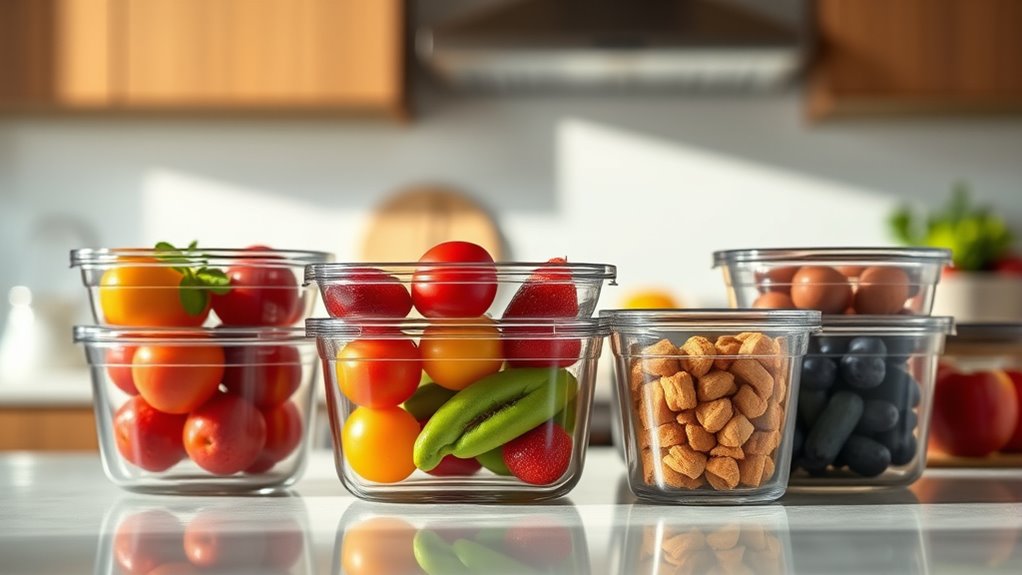
Glass containers offer numerous advantages for daily use, making them an excellent choice for everyday food storage. They are non-porous, preventing absorption of odors, flavors, and stains, which helps keep your food fresh. Unlike plastic, glass containers don’t leach harmful chemicals like BPA or phthalates, ensuring your food remains safe. Their resistance to temperature changes means you can refrigerate, reheat, or even bake in them without worry. The transparency of glass makes it easy to see what’s inside, helping you organize your kitchen and reduce food waste. Durable borosilicate glass can withstand thermal shock, adding to its reliability. Using durable materials also enhances safety and extends the lifespan of your containers. Although they can break if dropped, their overall durability and safety make glass containers a practical, long-lasting solution for daily food storage. Additionally, Cake Pops can be stored safely in glass containers, keeping their shape and flavor intact.
Challenges and Risks Associated With Glass Storage
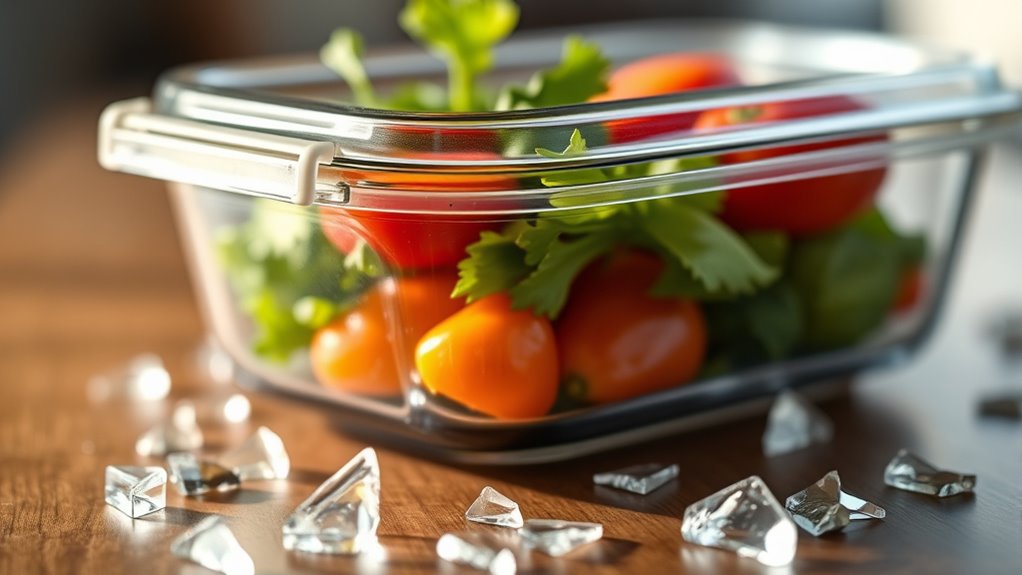
While glass containers are great for storing food, they are fragile and can break easily if mishandled or dropped. You need to be careful during transportation and use protective measures like silicone sleeves to prevent accidents. Additionally, sudden temperature changes can cause glass to crack or shatter, increasing the risk of injury and food loss. Understanding the contrast ratio of your glassware can also help you choose options that better suit your storage needs and reduce the likelihood of breakage. Proper handling and selecting durable materials can further mitigate these risks. Incorporating predictive analytics can help anticipate and prevent damage during storage or transport, enhancing safety. Using the appropriate headphone jack and connection method can also reduce accidents caused by tangled or damaged cords, ensuring safer handling. Moreover, being aware of celebrity lifestyle insights, such as the importance of resilience and adaptability, can inspire better practices in managing fragile items safely.
Fragility and Breakage Risks
Despite its popularity, storing items in glass containers carries inherent risks due to their fragility. Glass is prone to breakage if dropped or subjected to sudden impacts, increasing the chance of shattering during handling or transportation. This fragility makes glass less suitable for outdoor use or environments where accidental drops are common. Even tempered or borosilicate glass, which withstands thermal shocks better, can still crack or break under extreme conditions. Breakage not only results in costly replacements but also poses safety hazards from sharp shards. To minimize risks, careful handling and strategic storage—such as keeping containers in lower cabinets—are essential. Recognizing the fragility of glass helps you prevent accidents and protects you from potential injuries.
Handling and Temperature Changes
Handling glass containers carefully is essential to prevent damage caused by sudden temperature changes. Rapid temperature shifts, like moving glass directly from the fridge to a hot oven, can cause thermal shock, leading to cracking or shattering. Even tempered or borosilicate glass, known for resistance, can crack if exposed abruptly to extreme heat or cold. Proper handling involves gradually bringing your glass containers to room temperature before heating or cooling. This reduces the risk of thermal stress that can weaken the glass over time. Be especially cautious with older or damaged glassware, as they’re more prone to cracking under sudden temperature changes. Additionally, safety regulations emphasize the importance of inspecting glassware regularly for defects that could increase the risk of breakage. Using the correct cleaning techniques can also help prevent weakening glass over time. Choosing appropriate storage conditions helps maintain the integrity of glass containers and reduces the likelihood of accidents. By paying attention to handling and temperature adjustments, you can minimize breakage risks and extend the lifespan of your glass storage containers. Incorporating lifestyle habits such as mindful handling can further enhance safety and longevity.
Comparing the Durability of Glass and Plastic Options
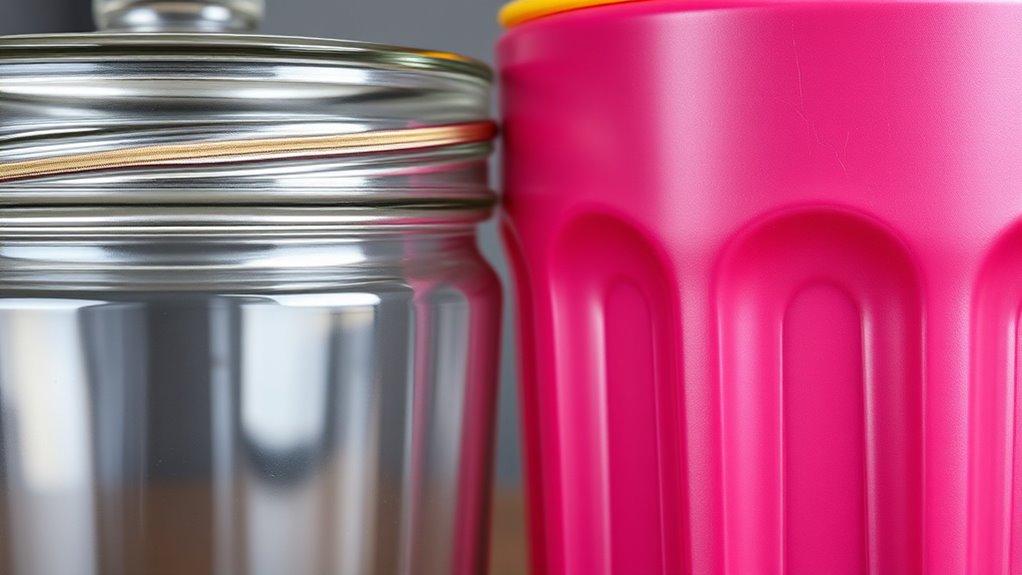
Glass containers are more prone to breaking or shattering when dropped or subjected to sudden impacts, whereas plastic options are designed to be shatterproof and withstand everyday knocks. Plastic storage is generally more durable during transport and outdoor activities, as it resists breakage better. Tempered or borosilicate glass can handle thermal shock and resist breaking under normal conditions, but mishandling still risks shattering. Plastic containers are lightweight, making them ideal for children or travel. While glass offers long-term durability against staining and warping, its fragility remains a key disadvantage.
| Material | Durability in Storage | Breakage Risk |
|---|---|---|
| Glass | Moderate | Higher |
| Plastic | High | Lower |
| Both | Varies | Depends on use |
Tips for Handling and Maintaining Glass Containers
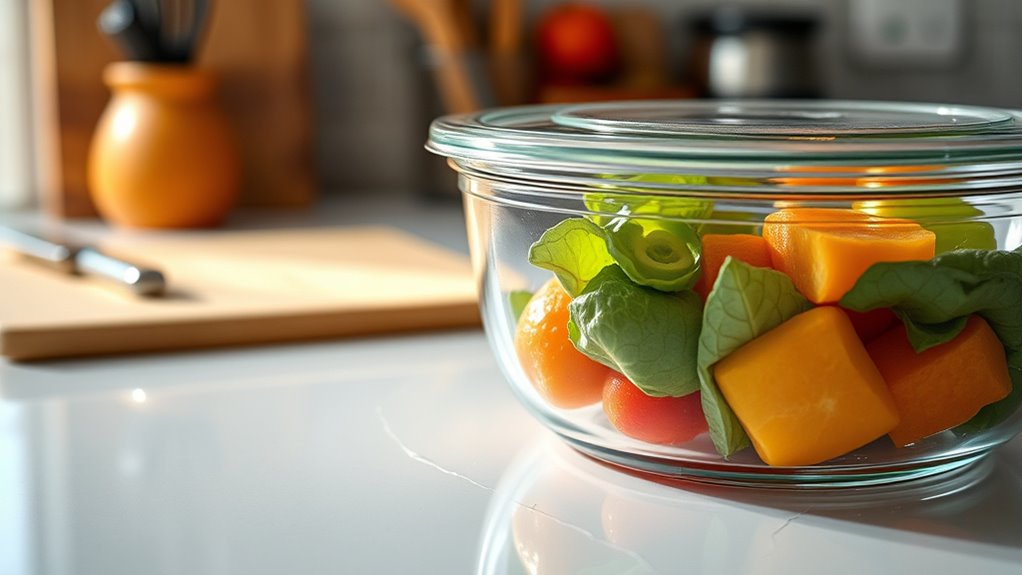
Handling glass containers carefully with both hands helps prevent accidents, especially when they’re full. Be mindful of temperature changes, letting hot foods cool before pouring to avoid cracks. Using proper stacking techniques and inspecting containers regularly keeps your glassware safe and in good condition. Additionally, understanding the fragility of glass can help you handle and store them more securely. For added safety, consider using protective pads or liners when stacking to cushion the containers and prevent scratches or breaks. Being aware of industry trends can also inform you about innovative storage solutions and safety accessories.
Handle With Care
To keep your glass containers in good condition, it is vital to handle them carefully at all times. Always use both hands when lifting or carrying full or heavy glass containers to guarantee safe handling. Store your glassware in secure, lower-cabinet spaces to prevent accidental drops and enhance storage safety. Avoid sudden temperature changes by letting containers reach room temperature before filling them with hot or cold foods, reducing the risk of cracks. Regularly inspect your glass for chips, cracks, or weaknesses to prevent unexpected breakage. Remember, gentle handling is key to prolonging their lifespan and maintaining safety.
| Handling Tips | Storage Tips |
|---|---|
| Handle with care to prevent breakage | Store in secure, low cabinets |
| Use both hands for stability | Check for cracks regularly |
| Avoid temperature shocks | Keep away from busy areas |
Temperature Change Caution
Since sudden temperature changes can cause glass containers to crack or break, it’s essential to handle them with care during heating and cooling processes. Rapid temperature fluctuations induce thermal shock, risking cracking or breaking due to uneven thermal expansion. Avoid pouring boiling liquids into cold glass or placing hot containers directly into cold water or the freezer. Instead, let glass reach room temperature first or reheat gradually with low heat or short microwave intervals. This careful approach minimizes stress fractures from thermal expansion differences. When transferring containers between hot and cold environments, always account for temperature change and give the glass time to adjust. By handling your glass containers thoughtfully, you reduce the risk of breakage and ensure their longevity.
Proper Stacking Techniques
Proper stacking of glass containers helps prevent accidents and extends their lifespan. To guarantee stability, always place heavier containers at the bottom of your stack, reducing the risk of tipping and breakage. Use non-slip shelf liners or soft cloths between containers to cushion edges and minimize movement during handling. Limit stacking to three or four layers to maintain stability and avoid accidental toppling. Before stacking, make sure lids are securely in place so containers don’t slip apart or fall. Handle the containers gently when stacking or unstacking, supporting the base fully to avoid applying undue pressure. Proper handling and attentive stacking techniques help preserve your glass storage and keep your kitchen safe from breakage risks.
Situations Where Plastic Might Be Preferable
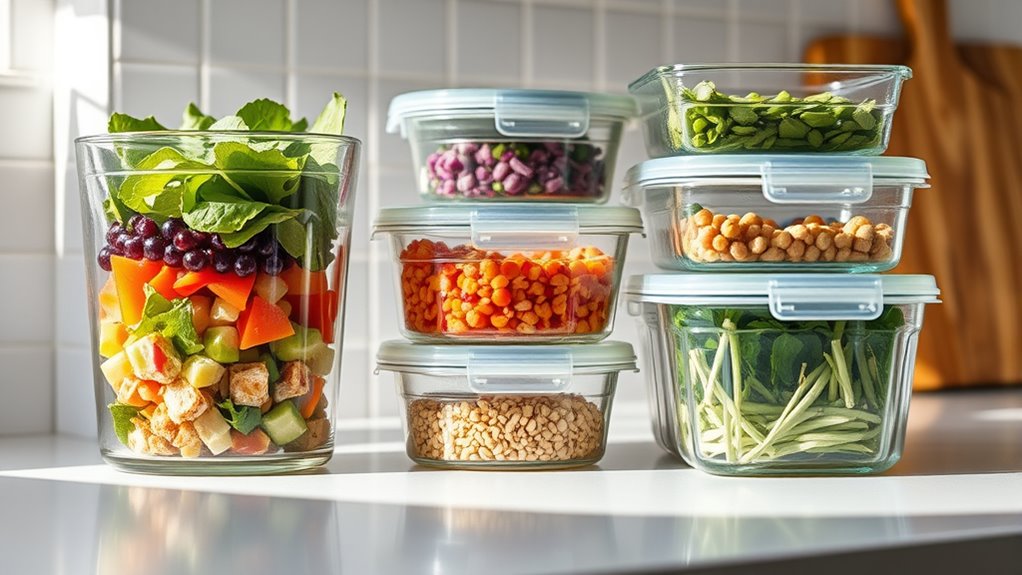
Plastic containers are often the best choice when you need lightweight, shatterproof storage for outdoor activities or travel. Their impact resistance makes them ideal for situations where breakage is a concern, especially when handling or transporting food on the go. They excel in portability, allowing you to easily carry snacks or meals without worry. Plastic is also cost-effective upfront, making it perfect for short-term or casual storage needs. If you’re packing lunches for kids or need durable containers that can withstand frequent handling, plastic’s impact durability is a major advantage. Additionally, containers with silicone or BPA-free lids are practical in environments where glass might be too fragile or impractical. For short-term use and active lifestyles, plastic offers a convenient, resilient option.
Making the Right Choice for Your Food Storage Needs

Choosing the right food storage containers involves evaluating your specific needs for safety, durability, and convenience. Glass food storage offers a chemical-free, non-porous option that enhances food safety by preventing harmful chemical leaching. It’s ideal for long-term storage, reheating, and maintaining food quality. While glass containers are environmentally friendly and recyclable, be mindful of breakage risk, especially during handling or outdoor use. To mitigate this, choose tempered or borosilicate glass for added durability. If you prioritize safety and food preservation at home, glass food storage containers are a smart choice. However, for portability or outdoor activities, plastic may be preferable. Matching your container material to your needs ensures safer, more practical, and longer-lasting food storage solutions.
Frequently Asked Questions
Is It Better to Store Your Food in Glass Containers?
You might wonder if storing food in glass containers is the best choice. Glass offers many benefits, including being non-toxic, BPA-free, and resistant to odors and stains, which helps keep your food safer and fresher longer. While there’s a breakage risk if dropped, the health and environmental advantages often outweigh this concern. If you’re careful, glass storage can be a reliable, healthier option for your kitchen.
What Is the Healthiest Glass Food Storage Container?
When choosing the healthiest glass food storage container, look for borosilicate glass, which is heat-resistant, durable, and free from harmful chemicals like BPA and lead. Opt for uncoated glass with silicone or natural lids to avoid chemical leaching, especially when heating or storing acidic foods. Select containers labeled BPA-free and lead-free, with airtight lids to keep food fresh and safe. Reusable, high-quality options support your health and the environment.
Is Glass Safer Than Plastic for Storing Food?
You might think plastic is safe, but glass is actually a safer choice for storing food. Unlike plastics, glass doesn’t leach harmful chemicals like BPA or phthalates, making it healthier. Plus, it doesn’t absorb odors or stains. However, be careful—glass can shatter with a loud crash that echoes like a thunderclap. So, while glass offers health benefits, handle it with care to avoid breakage.
Do Glass Containers Leach Chemicals Into Food?
You ask if glass containers leach chemicals into food. Generally, high-quality glass made from borosilicate or soda-lime doesn’t contain plastics or resins that can leach. It’s nonporous, so it doesn’t absorb odors or flavors, and it remains safe even when heated. However, be cautious with decorative or lead-glazed glassware, as it might contain heavy metals that could leach into your food, posing health risks.
Conclusion
So, when it comes to your food storage, choosing glass is like wielding the mighty sword of health and elegance—yet beware the treacherous land of breakage! Plastic might seem like the sneaky villain, but it won’t shatter into a million pieces with a single drop. Ultimately, you hold the power—pick the champion that best fits your lifestyle, and turn your kitchen into a fortress of freshness and safety!




